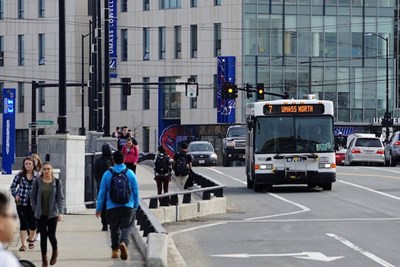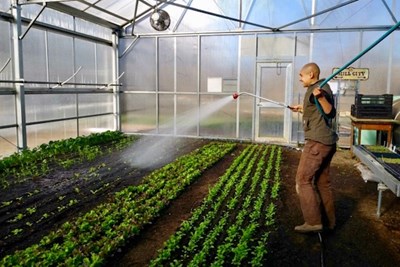UMass Lowell Serves as Catalyst for Conference-wide Collaboration
 Image by Ed Brennen
Image by Ed Brennen
03/05/2021
By Ed Brennen
Whether it’s on the field, court or track, UMass Lowell is usually competing against the nine other Division I schools from theAmerica East Conference.
But when it comes to sustainability, everyone is on the same team.
America East recently created a sustainability network that will give its 10 member institutions an opportunity to share best practices, build on existing partnerships and collaborate on new green initiatives. The network is a partnership with theAmerica East Academic Consortium, which facilitates academic and administrative collaboration between its schools.
And UMass Lowell is taking the lead. Director of SustainabilityRuairi O’Mahonyis serving as the network’s chair and will represent UML at monthly meetings along withRuben Sanca’09, ’10, assistant athletic director for administration.
“UMass Lowell is delighted to work with our America East partners in leading this endeavor,” says ChancellorJacquie Moloney. “We have had tremendous success in combining our athletic and sustainability efforts to enrich our student-athletes and enhance the fan experience. By working together, America East schools can carve out opportunities on the athletic, academic and operational fronts while advancing sustainability across the conference.”
“I’m really excited about it. It’s going to be a slam dunk,” adds O’Mahony, who pitched the idea to conference leaders last summer, sharing how UML’sOffice of SustainabilityandAthletic Departmenthave worked together to make athletic facilities across campus more energy efficient and environmentally friendly.
At the Tsongas Center, for instance, UML installed a Grind2Energy food waste recycling system in 2018, becoming the first college campus in the Northeast to do so. The university has also installed high-efficiency LED lighting and trash and recycling bins made from recycled milk jugs throughout the arena. Last year,two electric vehicle charging stationswere added in the arena’s parking lot.
 Image by Ed Brennen
Image by Ed Brennen
Using those successful initiatives as a model, one of the network’s first priorities is to create a “green sports playbook” that athletic departments can use to guide their decision-making on facility operations and marketing. The playbook is being developed in partnership with Casella Waste Systems, which recently named UML its “Innovator of the Year.”
“We’ve found that there are a lot of cost benefits of going green,” Sanca says. “A lot of companies want to sponsor and contribute to these green initiatives through strategic partnerships.”
Plans are also in the works for an in-person sustainability conference at UMass Lowell in June 2022 that will bring together students, faculty and staff from across America East, as well as national and international experts from the industry.
“As the member schools start to work together under a specific sustainability framework, it opens up huge potential for us to go after research grants, shared teaching opportunities and even joint energy purchases,” O’Mahony says.
He cites Mechanical Engineering Prof.Christopher Niezrecki’s joint research project on energy resiliency with fellow America East institution Stony Brook University as a perfect example. Last fall, the collaborative project received $7.36 million in funding from the U.S. Office of Naval Research.
Engaging student-athletes and teams in sustainability initiatives is another network goal.
Athletics brings visibility to a lot of programs, and it’s important that we use the platform we have to address these issues. -Ruben Sanca, asst. athletic director for administration.“Athletics brings visibility to a lot of programs, and it’s important that we use the platform we have to address these issues,” says Sanca, a former Olympic marathoner and standout distance runner for the River Hawks.
Sanca says current student-athletes could volunteer with sustainability efforts in the community, and the network could engage with alumni who have gone on to professional playing careers.
He adds that several NCAA athletic conferences across the country have started to focus on sustainability issues, led by the Pacific-12 Conference — which America East has used as a model for its new network.
In 2019, UML joined theGreen Sports Alliance, an environmentally focused nonprofit organization made up of nearly 600 athletic leagues, teams and venues from around the world.
Director of Athletics Peter Casey says the America East sustainability network is another opportunity for UML to grow its efforts at the regional and national levels.
“River Hawk Nation understands its duty of protecting the environment and stepping up our green game,” Casey says. “With our university partners' help, one of our goals is to educate and motivate our staff, student-athletes, and fans to take their own actions in helping protect the environment.”
America East, which spans from Maine to Maryland, hopes to establish itself as a national leader in sustainable practices, research and leadership.
“This is a high-stakes issue,” adds Marsha Florio, executive director of the America East Academic Consortium. “We look forward to working together to gain an understanding of what our campuses are doing in this area and building on it collectively as a group to create greener campus communities across the America East footprint.”




